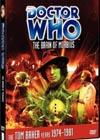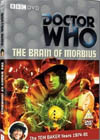DVD Extras include:
Broadcasting Glitches GaloreThis first criticism may be unfair, but even as late as the early 1990's, many North American stations were still transmitting movie length compilations and episodic versions of this story, in which the first 25 minutes contain no music or sound effects whatsoever. As if the production wasn't already too rough and unfinished as it was. In a good run of Tom Baker episodes, this is also often the first to still feature those ill-conceived patched on segments with narrator Howard da Silva spoiling the plot, trying to advertise upcoming events to those who were already watching, which usually caused a few scenes to be cut in order to keep the episode timing. Uggh!Which leads us to what may be the DVD's biggest selling point: a definitive, restored, fully intact version of the original story, which has been a rare find up until now. Collectors and horror fans will be thrilled. Casual viewers, general audiences, and sci-fi fans... perhaps not so much. Long before the DVD came out, I was not to be daunted, and dug into my library of music and sound effects to give the first 25 minutes of my PBS-broadcast Lionheart movie compilation version some atmosphere, and also to correct the silence of the police box's materialization. Even then, I find the story quite lacking. Obviously, it won't receive any bonus points for showing some TARDIS interior.
Redeeming Elements
That said, "The Brain of Morbius" has a lot of serious drawbacks. Apart from the few above-mentioned effects, the rest of the story's visuals are exceedingly depressing: an unending succession of dusty, dark old corners with slimy organic leftovers congealing all over the place. Not something I enjoy looking at for 100 minutes at a stretch.
Backstory Over Current StoryUltimately, the big failure in Terrance Dicks' attempted twist on Mary Shelley's "Frankenstein" is in the writing, butchered by Holmes and Hinchcliffe as it may have been. Most specifically, all the really interesting events have taken place before the story opens. Once the Doctor arrives, what does he really get to do? He never seems to take the threats seriously enough to form a solid plan of action to foil them, nor is he seen to act as an investigator. Instead we are subjected to some of the most poorly motivated and illogical capture and escape shuffles in the show's entire history.The Doctor does deliver a few really choice lines in the humour department, and the conversations delving into the backstory, rich as it is in fresh Timelord mythology, are among the most interesting bits. But none of this really makes up for the lack of good on-screen plot. When the Doctor isn't playing prisoner or the Man of Sleep, he's doing other silly things that I'll only elaborate on in detail in the In-depth Analysis version of this review. Attempts at "action" are far too primitive for a sci-fi show, bellowing "cheapie" loud and clear.
Should Doctor Who not Aim for Something Greater than Fear?Sick, dismal, and violent sums up this story's subject matter. Perhaps then this is a good time to discuss the infamous Mary Whitehouse and her crusade to clean up Doctor Who. She brings up a good point: with so many children watching the show, it does often get too focused on horror and violence to remain in good taste, but her reasoning and the examples she cites go so ridiculously overboard that it is little wonder how easily the show's defenders can brush her aside.Perhaps the most vivid example of the horror fans blindly taking their argument too far occurs in the pre-title opening of the documentary "More Than 30 Years in the TARDIS", in which quotes from the cast and viewers, building up a nostalgic love of fear, are voiced over scenes of a young boy running through the streets spotting imaginary alien monsters and shooting at them with a toy gun. It culminates with a quote from 7th Doctor Sylvester McCoy about the great influence Doctor Who has on young people growing up, which has probably been edited horribly out of its intended context as the boy keeps his gun aimed at the television on which the Doctor Who opening titles begin. I'm completely embarrassed at the lousy impression this documentary begins with, that expert creation of fear and violence is the positive impact Doctor Who has on young people. The positive impact is in the expansion of the imagination, in exploring science and new worlds, in embracing different cultures and learning to live in harmony with beings different from yourself, and in standing up for your beliefs and being willing to make a heroic difference in people's lives. The Doctor represents these things when he is at his best. Scary monsters are just a popular distraction, and redressing this balance of focus is one of the main aims of this series of articles and reviews. Movies and TV shows (not to mention video games) do put ideas in people's heads, and people recall those ideas when they are faced with problems and challenges and they need to come up with solutions. Video games even go so far as to train its players in whatever solutions it has to offer. What a great opportunity for sharing really outstanding positive ideas that help everyone! The Barry Letts team from the Jon Pertwee era did its fair share. "The Brain of Morbius", on the other hand, can boast nothing in this department. This story attempts to dwell on fears instead, which apparently makes a lot of people enjoy a film. Personally, I don't get it. Fear is not high on my list of sought-after emotions. An insignificant bit of Timelord mythology aside, "The Brain of Morbius" really has little else going for it to make it interesting for the larger audience who tune in to Doctor Who for a wider variety of reasons. This one is for the horror fans only. My criticism of the violence in Doctor Who is not so much that it is too frightening for the children, as Mary Whitehouse often argued. Kids enjoy good adventure stories, and can tolerate violent subject matter that often comes part and parcel with it, especially if human history is to be portrayed accurately. But I don't buy the defense put forth by Eric Saward in "More Than 30 Years in the TARDIS", when he says that showing that violence hurts is enough to put everything into perspective for kids and deter them from using it themselves. After all, it's meant to hurt the other person, and not the one who decides to use it, right? A far better deterrent is to show that violence doesn't solve problems, and that it in fact makes them worse. This is not so hard to do, if one pays attention to the way things work in the real world, and if one allows the script time to deal with the social consequences of violence after the act. The trouble is, too many stories end with the violent act as their climax, and allow heroes as well as villains to use violence to "solve" their conflicts. In many ways, it's a writer's cop-out from thinking of a more elegant solution.
The Nail of Illogic in the Coffin of Bad TasteThis brings us to cyanide. What a ridiculous sequence. Without spoiling anything in this version of the review for those who haven't seen the story, this is possibly the worst example that Doctor Who has ever set for its viewers - as there are easily a hundred more moral, logical, and entertaining devices the script could have used.So, my apologies to all the horror fans, but "Brain of Morbius" is a huge stinker in my books.
This story has become available on DVD and VHS video:
Comments on this article are welcome. You may contact the author from this page:
|










